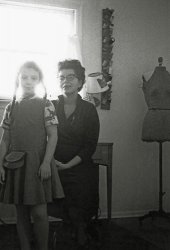
MAY CONTAIN NUTS

Search Shorpy
SHORPY ART

Framed or unframed, desk size to sofa size, printed by us in Arizona and Alabama since 2007. Explore now.
Join and Share
Ad-Free Shorpy
Shorpy is funded by you. Patreon contributors get an ad-free experience.
Learn more.

Recent comments
- Baldwin 62303
- Baldwin VO-1000
- Cold
- No expense spared
- Tough Guys
- Lost in Toyland
- And without gloves
- If I were a blindfolded time traveler
- Smoke Consumer Also Cooks
- Oh that stove!
- Possibly still there?
- What?!?
- $100 Reward
- Freeze Frame
- Texas Flyer wanted
- Just a Year Too Soon
- WWII -- Replacing men with women at the railroad crossing.
- Yes, Icing
- You kids drive me nuts!
- NOT An Easy Job
- I wonder
- Just add window boxes
- Icing Platform?
- Indiana Harbor Belt abides
- Freezing haze
- Corrections (for those who care)
- C&NW at Nelson
- Fallen Flags
- A dangerous job made worse
- Water Stop
Member Photos
The Shorpy
Print Emporium
Print Emporium
Search Shorpy
Search results -- 30 results per page
- Princeton Hockey: 1910
- The Princeton hockey team circa 1910. View full size. G.G. Bain Collection.
Princeton Tough looking dudes. Very cool team logo.
Wow! That guy in ... Posted by Dave - 04/07/2008 - 5:49pm -
![Princeton Hockey: 1910 The Princeton hockey team circa 1910. View full size. G.G. Bain Collection.
PrincetonTough looking dudes. Very cool team logo.
Wow!That guy in the middle is awesome. I love the interesting faces that always pop up in these old photos.
Hmmm...No helmets, few pads and they all seemed to have most of their teeth. Was hockey that much genteel back then?
Hobey Baker?Isn't the player second from the left the great Hobey Baker? He is probably the most famous amateur player of his time and had his life not been cut short during WWI there may have been a greater legacy left behind. The Hobey Baker Award keeps his name and legend alive.
[Hobey (below) isn't in this photo. - Dave]
(The Gallery, G.G. Bain, Sports)](https://www.shorpy.com/files/images/08845u.thumbnail.jpg)
- The Fake: 1957
- ... Oklahoma State University?
Unless It's a Fake Princeton.
Rah! Rah! Sis boom bah! Syracuse it is.
My Guess Dear old UVa?
Princeton -- Ivy League Champs in 1957 Fred Tiley?
Go Tigers! I ... Posted by Dave - 09/24/2014 - 4:16pm -
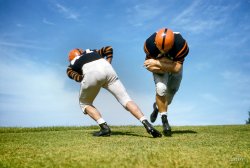
- Brown of Princeton: 1915
- "Brown of Princeton" circa 1915-1920. View full size. G.G. Bain Collection.
Wet ... Posted by Dave - 03/26/2008 - 9:00pm -
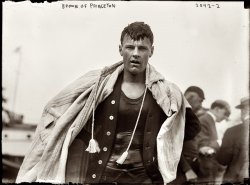
- Penfield of Princeton: 1911
- Sept. 25, 1911. Princeton tackle (and later noted brain surgeon) Wilder Graves Penfield. View ... Posted by Dave - 02/03/2008 - 6:34pm -
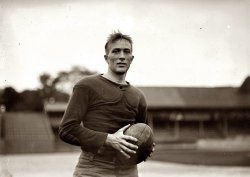
- Driveway Stroll: 1963
- ... early 1963, around six months after we moved into our new Princeton, New Jersey house.
Like in Levittown, my family were the original ... in my family’s vocabulary.
Sleepy brother / sleepy Princeton Back when it was still pretty rural around those parts...but ... Posted by aenthal - 04/06/2018 - 7:09pm -
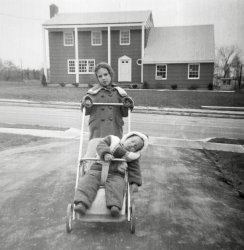
- Hobey Baker: 1913
- September 11, 1913. "Hobart Baker, Princeton football captain." Hobey Baker, better known as captain of the Princeton Tigers hockey team, was a World War I Army pilot who was killed when ...
Fitzgerald's Idol F. Scott Fitzgerald and other Princeton underclassmen idolized Baker. Fitzgerald was supposed to have based ... Posted by Dave - 04/11/2008 - 2:21pm -
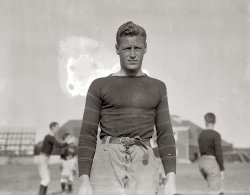
- Home Sweet Home Home Home
- ... of Columbia, 1919 or 1920. "Washington Times, 609 to 637 Princeton Street." View full size. National Photo Company Collection glass ... $445k According to zillow.com the current value of 639 Princeton Place is $445,000 .
637 Princeton Place Northwest, Washington, ... Posted by Dave - 09/11/2011 - 4:13pm -
![Home Sweet Home Home Home District of Columbia, 1919 or 1920. "Washington Times, 609 to 637 Princeton Street." View full size. National Photo Company Collection glass negative.
Thanks to Stanton SquareI would like to thank Stanton Square for the articles and pictures he provides to add to our knowledge of places like this.
RowhousesCould be from a current brochure!! Very contemporary.
[Nowadays you'd most likely see brick on the front and vinyl siding left, right and rear. - Dave]
Still thereStill there (click image to enlarge):
TodayNot to mention that you could very well pay as much for one house as the original builder spent to build the whole street.
This Old HouseYou got that right, Brent. My parents' first home, a new rowhouse in the Sunset District of San Francisco, cost $5,000 in about 1939. Last I heard that same house would cost close to $400,000!
$445kAccording to zillow.com the current value of 639 Princeton Place is $445,000.
637 Princeton Place Northwest, Washington, DC
Public Facts:
* Single family
* 4 beds
* 3.0 bath
* 1,928 sqft
* Lot 1,844 sqft
* Built in 1920
Popular Colonial Design.Herman R. Howenstein was another active builder in early 20th century Washington. According to his brief bio at the Capitol Hill Restoration Society, he was also the builder and owner of the Potomac Park Apartments.
Washington Post, May 25, 1919
With plans completed for the erection of 135 new homes of various types in the northwest section at a cost of nearly $500,000, the firm of H.R. Howenstein Company have undertaken on of the largest building enterprises of the year. The firm now has almost completed the 50 homes which have been under construction several months.
Preliminary to the construction work was the purchase last week by this firm from the Kennedy Brothers, Inc., of all the vacant ground fronting on five squares between Park place, Warder street, Georgia avenue, Otis, Princeton, Quebec streets and Rock Creek Church road. The tract comprises 135 building lots.
The new homes to be erected on this tract will be of five different types and of popular colonial design. A new idea will be followed in building a fireproof garage under each rear porch, with heat and light from the house. The homes will be placed on the market as rapidly as they are completed.
Washington Post, Feb 29, 1920: Advertisement
609 to 637 Princeton street N.W.
Open and Lighted Until 8 o'Clock P.M. Daily
A Large, Light Fire-Proof Garage goes with each house.
Take Ninth Street Car to Quebec Street and Walk One Square East, or Phone Us for Auto.
H.R. Howenstein Co.
1314 F St. N.W. - 7th and H Sts. N.E.
$3,000 each609-637 were all built for $45,000, or $3,000 each. H.R. Howerstein, owner and builder, got his permit on June 21, 1919. W.E. Howser was the architect. He also built the 16 on the even side for $48,000.
(The Gallery, D.C., Natl Photo)](https://www.shorpy.com/files/images/28965u.thumbnail.jpg)
- The Unknown Scrummers: 1920
- ... in 1920, compared to just one road game (a 14-0 loss at Princeton) and their traditional neutral-site game against Army at the Polo ... Posted by Dave - 08/04/2012 - 3:11am -
![The Unknown Scrummers: 1920 Washington, D.C., or vicinity circa 1920. The caption just says "football." Who can identify the venue? Harris & Ewing Collection glass negative. View full size.
Mother BIsn't that Bancroft Hall at the U.S. Naval Academy in Annapolis?
Narrowing it downNavy played six home games in 1920, compared to just one road game (a 14-0 loss at Princeton) and their traditional neutral-site game against Army at the Polo Grounds in New York (a 7-0 victory.) These six home games were:
October 2: 14-7 loss to North Carolina State
October 9: 12-7 defeat of Lafayette
October 16: 7-2 defeat of Bucknell
October 30: 47-0 defeat of Western Reserve
November 6: 21-6 defeat of Georgetown
November 13: 63-0 defeat of South Carolina
[This could have been taken anytime from 1910 to the early 1920s. - Dave]
Next to BancroftOn the left it's either the Seamanship Building or the Armory on the Naval Academy campus. As this 1919 panorama shows, they were already bookends of Bancroft Hall and its yards. They're now known as MacDonough and Dahlgren Halls.
Go Navy!It's Bancroft, indeed.
The shot is taken from the football field (now basically just a track), looking back at the "T" section of the rear wing of the dorm in the upper-left (which now has a 2-story walkway connecting it to the main building).
http://www.bing.com/maps/?v=2&cp=qgxdyn8mssvt&scene=25283264&lvl=1&sty=b
Beat Army!Swein is close, but I think you're on the wrong side of Bancroft. This shot is at Thompson Field, where Navy played their football games before the Navy-Marine Corps Memorial Stadium was built in 1959. It was situated where LeJeune Hall (the pool) and the 8th Wing of Bancroft stand today. The buildings seen in this picture are, I believe, the 6th Wing of Bancroft and, to the left, just the corner of Dahlgren Hall.
Love the stitched-on number patches. Would be interesting if anyone could figure out which game this was. The helmet "technology" seems to place it somewhere in the teens or '20s.
Back in the dayPeople talk about how violent the sport is today, but the 1909 football season saw 26 deaths on both college and professional teams during the regular season. This was more than double that of the 1908 season.
Navigation, please!!The photo is of Bancroft Hall at Annapolis but it's taken from due south of the campus. The corner of Dahlgren Hall is just showing to the far left and the sixth wing of Bancroft Hall is in the immediate background. The fifth wing is in the far background. The photo is taken from near what is today the site of Lejeune Hall.
Action!The wonderful depth of field, the slightly skewed horizon and the players frozen in various athletic postures make this a superb action shot. A great sports picture!
1922Based on a comparison to pictures in the Naval Academy's 1923 yearbook, this would appear to be Navy vs. Georgia Tech, 10/21/1922.
http://media.scout.com/media/image/78/780837.jpg
Note #27 in both pictures.
1922, Georgia TechMike, thanks for determining the opponent! You made my day!
Perhaps Georgetown?Georgia Tech isn't listed as an opponent, but Georgetown is. And Georgetown wore uniforms similar to those shown in this photo. Examples here and here.
BTW, I love this site and have been working my way forward from the original photo of Shorpy Higgnbotham. I can't seem to get enough!
(The Gallery, D.C., Harris + Ewing, Sports)](https://www.shorpy.com/files/images/29339a.thumbnail.jpg)
- Cranbury-Bound: 1940
- ... refer to Cranbury, a nice little town a few miles east of Princeton.
That Tie! This young man is barefoot, but still rocking a ... Posted by Dave - 04/30/2021 - 8:30pm -
![Cranbury-Bound: 1940 July 1940. "Near Shawboro, North Carolina. Group of Florida migrants on their way to Cranberry [i.e., Cranbury], New Jersey, to pick potatoes." Some of the folks last seen here -- 12 years ago! Photo by Jack Delano for the Farm Security Administration. View full size.
Original caption writer nodsI believe the original caption was intended to refer to Cranbury, a nice little town a few miles east of Princeton.
That Tie!This young man is barefoot, but still rocking a tie! Looks ready for a fight to protect everything they have strapped to that car. Amazing photo.
Tag10 = Broward County
Boxer PoseThe young man is giving his all to his inner Joe Lewis.
Rough RoadsThe collision damage may have helped get it started, but that crack on the front fender is a stress crack from the constant shaking and bouncing of the rough ride.
Car ID1935 Studebaker Dictator.
[1934, not 1935. - Dave]
Solution to a knotty problemMy son's solution: "If you can't tie a knot, tie a lot." (He resisted my instruction in this matter.)
American BeautyI highly recommend to everybody to follow Dave’s “last seen here” link to see one of the all-star Shorpy photos of all time. If there are any more with that amazing woman in them, I would love to see them, please.
Unfortunate NameThe rise of Adolf Hitler prompted Studebaker to abruptly discontinue the name "Dictator" in 1937, resurrecting the Commander name, which had been dropped in 1935.
For that reason, maybe you could get these newish cars cheap. Still, asking 1,300 hard miles from it was a risky proposition.
The Pep Boys lost their case In 1938 The Pep Boys—Manny, Moe & Jack tried to prevent Pure Oil from using the term "Pep" in their advertisements, unfortunately for them they lost their case.
The Official Gazette of the United States Patent Office reports:
THE PEP BOYS - MANNY, MOE AND JACK v. AMERICAN OIL COMPANY, Cancellation No. 2870. In a decision rendered April 21, 1938 ( 163 Ms. Dec. 24 ), Assistant Commissioner Frazer held that American Oil Company, of Peoria, Ill., was entitled to register the term “ Pep ” as a trade - mark for gasoline and fuel oil for combustion motors, and that the registration which it had obtained should not be cancelled. The ground of the decision is that the petitioner for cancellation has not shown itself to be damaged with the registration and that the word is not descriptive of the goods.
(The Gallery, Agriculture, Cars, Trucks, Buses, Jack Delano, Kids)](https://www.shorpy.com/files/images/SHORPY-8c02709a.thumbnail.jpg)
- Big Bill Edwards: 1915
- ... internal revenue for the Wall Street district and former Princeton football star, delivering a speech circa 1915. View full size. ... be sure:
"People who called Edwards the Peter Pan of Princeton, who were bored by his after-dinner speeches, who declared that he ... Posted by Dave - 09/08/2011 - 10:03pm -
![Big Bill Edwards: 1915 William Edwards, a.k.a. Big Bill Edwards, collector of internal revenue for the Wall Street district and former Princeton football star, delivering a speech circa 1915. View full size. 5x7 glass negative, George Grantham Bain Collection.
Hats!Wow. I think everybody is wearing a hat ... times sure have changed.
Big Billthe Edwards Boy mystery solved!
Nice hat...no, not you, you.Nice hat...no, not you, you. Nope, next to him - oh, forget it.
re: Big BillNow I read that Big Bill was unmarried, so that must be someone else's "Edwards Boy".
But "Big Bill" was a character, to be sure:
"People who called Edwards the Peter Pan of Princeton, who were bored by his after-dinner speeches, who declared that he was at heart a schoolboy who blustered his way through life seeking the loud worship of some irrecoverable football game, such people ate their words the day he stood next Mayor Gaynor. For a maniac, jerking out a pistol, emptied it at New York's good Mayor. "Big Bill" Edwards, for one moment of splendor, got back the glory of the greatest game that he had ever played as with a mechanical impulse he leaped for the murderer. There were detectives in the group that day, men trained for just such moments. "Big Bill" Edwards acted quicker than any of them. Straight as a bullet he launched his enormous bulk forward in a flying tackle that had in it all that nerve and muscle remembered of wild times on ringing fields. The gunman, still firing, crumpled backward; powder burned the sleeve of "Big Bill" Edwards; a bullet seared his arm. For a while after that he was cheered wherever he went. " - Time Magazine, Oct. 4, 1926
[The Edwards boy pics were taken by National Photo in Washington; this Bain News Service photo was taken in New York. - Dave]
With a piano?I'd be curious to know in what capacity that piano was used to augment Big Bill's speech.
Big BillIf there was ever a movie of Big Bill it would have to be John Goodman that played him...
(The Gallery, G.G. Bain, Public Figures)](https://www.shorpy.com/files/images/27645u.thumbnail.jpg)
- 85 Leabrook Lane: 1964
- ... Along with making us matching RCA Picnic shirts in Princeton, she made matching red dresses for her, me, and a tiny one that was ... milk to our house, using it.
Milksicle, Anyone? Princeton NJ probably wasn't as cold as Winnipeg, and the box had thick ... Posted by aenthal - 04/20/2018 - 8:01pm -
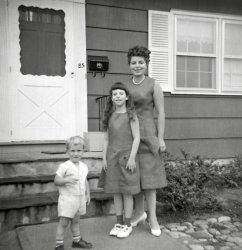
- Now Playing: 1920
- ... on Georgia avenue, occupying the entire area between Princeton and Quebec streets. The newest of the Crandall theaters will have a ... Posted by Dave - 07/17/2012 - 10:16pm -
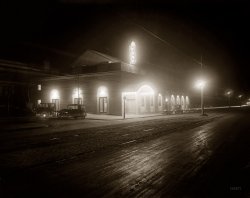
- Miss Cleveland: 1918
- ... on the day of the wedding, as the ceremony was held in Princeton. That again would have been very common in this time period - ... Posted by Dave - 08/28/2012 - 12:07pm -
![Miss Cleveland: 1918 Washington, D.C., circa 1918. In the inimitable stylings of Harris & Ewing: "Cleveland, Esther, Miss. Group." Esther Cleveland at right, daughter of Grover Cleveland, the only presidential child born in the White House. View full size.
Could that possibly bean antimacassar protecting those pillows behind her? I never thought I would have the opportunity to actually use that word.
[Technically it's a crocheted pillow sham. An antimacassar, though also usually crochetted, is in the form of a doily. I can't fault you for trying to use one of my favorite words, though. - tterrace]
[The Cleveland administration was on record as being strongly pro-macassar. -Dave]
Not crochetThat topmost pillow sham is actually Battenburg lace, made by cutting fabric (usually cotton muslin) into intricate shapes and filling the gaps with linen braid. It's nothing like crochet, and requires different skills and tools.
Also, most antimacassars in the age of macassar oil were of thick woven fabric embellished with embroidery. Lace antimacassars only became more popular after men stopped using the oil - cleaning lace is a real pain in the behind, so why place a lace item where it's expected to get dirty constantly?
The bodice of her dress is also lace; I'm not certain whether it's crocheted, knitted, or woven, but I'd put my money on woven if only due to the gossamer thinness of the fabric. I knit and crochet lace, and it looks to me to be too fine to hand-produce.
now that's class...both of the dresses are absolutely beautiful!
The Trolley ProblemEsther's daughter was the philosopher, Philipa Foot, the originator of the trolley problem - should you throw the switch and kill the innocent pedestrian but save everyone on the trolley?
Oil paintingThis reminds me of a Sir Lawrence Alma-Tadema painting.
Might be late 1917This appears to be a formal pre-wedding portrait of the woman on the left, Marion Cleveland, and her younger sister Esther. Marion's wearing a wedding dress without a veil, which is common for this kind of portrait at this time period. Also, their hairstyles would have been completely out of date by 1918.
Marion Cleveland was married on November 28, 1917. Had the photo been taken after her marriage, she would have been Mrs. William Dell. Before her marriage, however, she would have been referred to simply as "Miss Cleveland", which may explain the caption: Miss Cleveland and Esther Cleveland.
I suspect the photograph was not taken on the day of the wedding, as the ceremony was held in Princeton. That again would have been very common in this time period - pre-wedding photos would be taken days or weeks in advance.
Just say no to Macassar?It would have made my work easier if they'd actually used the oil! But nevertheless, here they are in color. The larger color version is here.
(The Gallery, D.C., Harris + Ewing, Pretty Girls)](https://www.shorpy.com/files/images/SHORPY_17305a.thumbnail.jpg)
- Fast Learners: 1908
- ... meets it participated in during the year (Annapolis and Princeton). The meets consisted of the following events: 100 and 220 yard ... Posted by Dave - 02/09/2013 - 8:58pm -
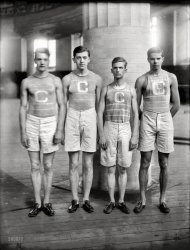
- The Ink Spot: 1922
- ... administration. Though many regard the former president of Princeton University as a liberal and forward thinker, he brought with him to ... Posted by Dave - 08/27/2012 - 3:19pm -
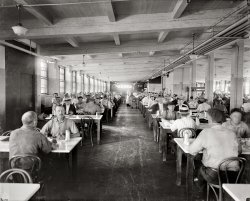
- Beam Me Up: 1940
- ... Floor, the Twilight Zone The branch of Bambergers in Princeton New Jersey that my family took me shopping at, in the mid 1960's, ... Posted by Dave - 08/12/2013 - 12:33pm -
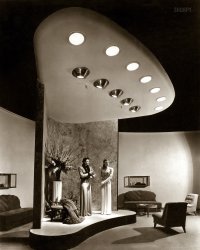
- Fuld House: 1944
- ... were to be what became the Institute for Advanced Study in Princeton. The IAS was, among other things, Einstein's employer. The ... Posted by Dave - 01/07/2015 - 8:03pm -
![Fuld House: 1944 August 30, 1944. "Felix Fuld Houses. Newark Housing Authority, 57 Sussex Avenue, Newark, New Jersey." Gottscho-Schleisner photo. View full size.
6 Degrees of Albert EinsteinFelix Fuld was Louis Bamberger's sister's husband. Together, they owned Bambergers, which was THE New Jersey department store. They all lived together on a large estate in South Orange NJ which was beautifully landscaped by the Olmsted firm. (If Shorpy ever runs out of Library Of Congress pictures, they'd do well to raid the National Park Service Olmsted archives.). Right before the market crash, Bambergers was sold to Macy's. The Bambergers and Fulds proceeded to give away gigantic sums of money. Originally, they wanted their estate to become a think tank of sorts, but were later convinced it would be better if it were to be what became the Institute for Advanced Study in Princeton. The IAS was, among other things, Einstein's employer. The Bamberger estate ended up as a Veterans hospital, and Bambergers in Newark is a server farm.
Apt. Building 851Is this photo flipped/reversed?
[evaD - .ylbissoP]
Clever, Dave! LOL
Me TooNoticed picture got flipped. Maybe someone saw the apartment number was backwards.
Not flippedThe photo isn't flipped because the push panel on the top of the trashcan still says "PUSH" the right way round!
[It was flipped, until we fixed it. Capisce? - Dave]
Now a ParkTorn down to become Nat Turner Park.
Demolished in 2007Article here.
(The Gallery, Gottscho-Schleisner, Kids)](https://www.shorpy.com/files/images/SHORPY-5a11126u.thumbnail.jpg)
- The Big Game: 1912
- ... 12th. (The Top 5 were Harvard, Wisconsin, Chicago, Princeton and Minnesota.)
(The Gallery, D.C., Harris + Ewing, Sports) ... Posted by Dave - 08/27/2012 - 1:19pm -
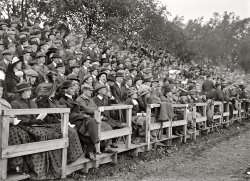
- Freddie the Newsie: 1915
- ... went on to have a wonderful life after he graduated from Princeton in '34!
See http://tinyurl.com/ywdhee !
The time frame ... Posted by Dave - 02/15/2008 - 3:22am -
![Freddie the Newsie: 1915 May 1915. Sacramento, California. "Freddie Kafer, a very immature little newsie selling Saturday Evening Posts and newspapers at the entrance to the State Capitol. He did not know his age, nor much of anything else. He was said to be 5 or 6 years old. Nearby I found Jack, who said he was 8 years old, and who was carrying a bag full of Saturday Evening Posts, which weighed nearly half of his own weight. The bag weighed 24 pounds, and he weighed only 55. He carried this bag for several blocks to the [street]car. Said he was taking them home." Photograph and caption by Lewis Wickes Hine. View full size.
Freddie the NewsieLittle Freddie appears to be wearing a child-size version of carpenter's bib overalls. The slim vertical pocket is to hold a carpenter's flat pencil.
I wonder how high these very young children could count. Probably they rarely if ever had to make change for a purchase. But they would have to trust an adult to settle their accounts and pay them their meager earnings.
That Bagis almost as big as he.
Possible good news about Freddie!If his obit is on this page, he went on to have a wonderful life after he graduated from Princeton in '34!
See http://tinyurl.com/ywdhee !
The time frame works...if he turned 87 in Jan. of '98, he was born in 1911 and would have been 4 at the time of the picture...a little younger than Mr. Hine's estimated 5 or 6.
(The Gallery, Kids, Lewis Hine)](https://www.shorpy.com/files/images/05577u.thumbnail.jpg)
- Picnic Shirts: 1966
- ... me with my five-year-old brother in front of the Princeton house wearing my (former) Picnic Shirt. In the background is my ... was a rental car.
This would be our last full year in Princeton. Though it was built for us to be our permanent home, it is the house ... Posted by aenthal - 09/08/2017 - 8:32pm -
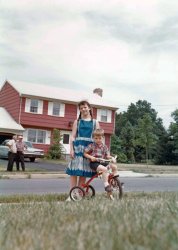
- Five o'Clock Shadows: 1939
- ... of Listerine, but worked hard to make a name for himself. Princeton Magazine has a great article about him.
(The Gallery, ... Posted by Dave - 04/30/2019 - 10:33pm -
![Five o'Clock Shadows: 1939 April 1939. "Miami Beach home of former Gillette Razor Blade Company president." Medium format negative by Marion Post Wolcott for the Farm Security Administration. View full size.
Those Palm TreesNeed a shave and a haircut. For two cents I would give them one.
FSA subject matter?What was Wolcott trying to tell us with this photo?
The FSA was created to assist poverty-stricken farmers and its photographers were tasked to document the lives of those who endured an impoverished rural lifestyle.
Neither Miami Beach nor its residents would seem to qualify as subject matter.
[The mandate of the FSA photography project, as distinct from the Farm Security Administration itself, evolved after the Dust Bowl years to include the documentation of American life in general, as well as Resettlement Administration activities. Three years after this, it became the Office of War Information photography project. - Dave]
Sharp looking house!Bet a lot of cutting edge technology went into the construction.
Gerard LambertHe was the son of the founder of Listerine, but worked hard to make a name for himself. Princeton Magazine has a great article about him.
(The Gallery, Florida, M.P. Wolcott, Miami)](https://www.shorpy.com/files/images/SHORPY-8c09809a.thumbnail.jpg)
- Suburban Dreams: Winter 1963
- We moved into the new house at 85 Leabrook Lane, Princeton, NJ, on July 30, 1962. After we moved in a lawn was planted and the ... Posted by aenthal - 09/06/2013 - 7:06pm -
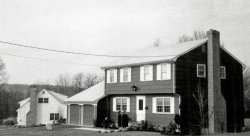
- TV and Me: 1955
- ... RCA TVs because my father worked at RCA Laboratories, in Princeton New Jersey, where he was involved in the development of color ... Posted by aenthal - 02/17/2018 - 12:32pm -
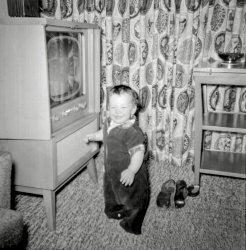
- Picnic Shirts: 1963
- ... There were basically two groups of people who lived in Princeton, New Jersey during the 1960s: people connected to the University and ... Posted by aenthal - 09/08/2017 - 8:33pm -
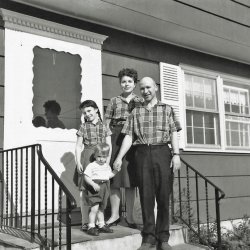
- Beat It: 1963
- A third look at our 1962 Princeton, New Jersey kitchen. This time, instead of bathing my brother, my ... Posted by aenthal - 01/05/2018 - 7:32pm -
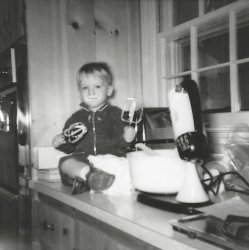
- A Great Hiding Place: 1962
- ... of the Levittown era of my childhood. Our next home in Princeton, New Jersey was being built for us by this time.
Since one of my ... Posted by aenthal - 08/25/2017 - 7:33pm -
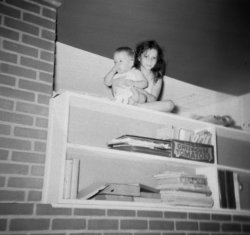
- Suburban Dreams: Spring 1962
- ... a builder to create their dream home at 85 Leabrook Lane, Princeton, New Jersey. As it was getting close to completion, we drove over ... Posted by aenthal - 09/06/2013 - 9:56pm -
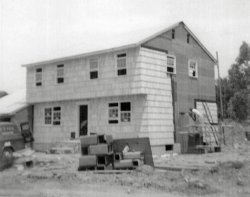
- Bathtime For Baby: 1962
- Our Princeton, New Jersey house was built for us in the spring of 1962. On the ... Posted by aenthal - 01/05/2018 - 7:32pm -
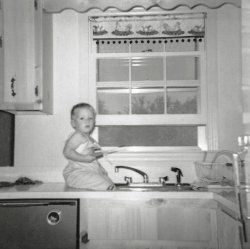
- Space-Age Kitchen: 1963
- A second look at the 1962 kitchen of our Princeton, New Jersey house, featuring the chicken-and-nest window shades my ... Posted by aenthal - 01/05/2018 - 7:32pm -
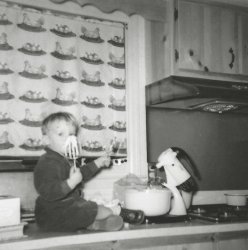
- Sewing Room: 1963
- ... mother’s sister Harriet came to visit our new house in Princeton, New Jersey and took a whole roll of 35mm film featuring our family ... Posted by aenthal - 11/24/2017 - 7:17pm -
